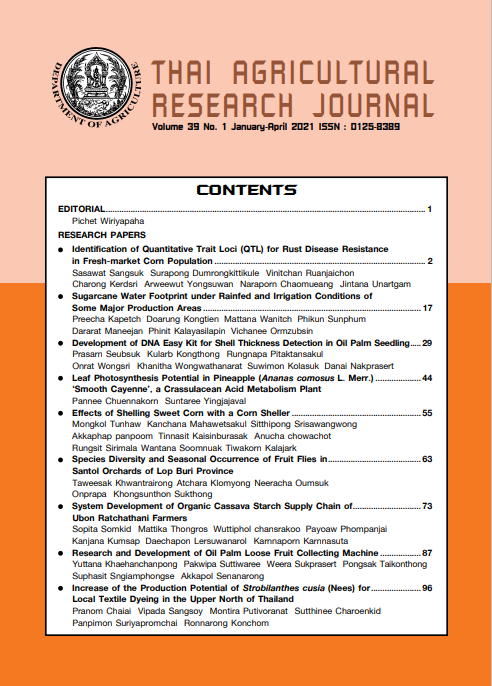Identification of Quantitative Trait Loci (QTL) for Rust Disease Resistance in Fresh-market Corn Population
DOI:
https://doi.org/10.14456/thaidoa-agres.2021.1Keywords:
Corn, Puccinia polysora, Genome Wide Association studyAbstract
Southern rust disease caused by Puccinia polysora Underw. is the main problem of corn production in Thailand. The objectives of this study were screening resistance varieties of corn to P. polysora and identifying quantitative trait loci (QTL) associated with the resistance. Two isolates of P. polysora were morphologically characterized, and sequentially analyzed in the ITS rDNA region. Results revealed that both isolates could be grouped with P. polysora from Genbank (NCBI) with 99% bootstrap supporting. Resistance evaluation of 66 lines of sweet corn and waxy corn against these two isolates found that Bio18-1 and Bio18-35 lines were highly resistance. They were suitable candidates for further investigation of resistant sources to corn rust disease. In addition, we found that each inbred line showed different degrees of resistance and susceptibility to P. polysora collected from different sources. Therefore, more than one fungal isolates should be used in the breeding programme for corn rust resistance in Thailand to ensure that resistance obtained are effective against wide range of isolates present in the country. To identify genomic regions associated with rust resistance in maize, a genome-wide association analysis (GWAS) was conducted using 159,201 single-nucleotide polymorphism (SNP) markers of the 66 corn lines. Results showed that the two QTLs significantly associated with rust resistance were on chromosome 10 which was against Chiang Mai isolate and onchromosome3 which was against Nakhon Ratchasimaisolate. For futureanalysis, SNP markers and haplotype associated with 2 QTLs will be developed and evaluatedfor rust resistance in corn breeding programme.
References
จินตนา อันอาตม์งาม. 2562. เทคนิควิจัยเชื้อราสาเหตุโรคพืช. สำนักพิมพ์ศูนย์ส่งเสริมและฝึกอบรมการเกษตรแห่งชาติ มหาวิทยาลัยเกษตรศาสตร์ วิทยาเขตกำแพงแสน, นครปฐม.
ปัทมา จันทร์เรือง. 2555. การศึกษาความผันแปรทางพันธุกรรมของเชื้อราสนิมบนข้าวโพดสายพันธุ์แท้เกษตรศาสตร์. วิทยานิพนธ์ปริญญาวิทยาศาสตร์มหาบัณฑิต มหาวิทยาลัยเกษตรศาสตร์ วิทยาเขต กำแพงแสน, นครปฐม.
สำนักงานเศรษฐกิจการเกษตร. 2562. ส่งออกข้าวโพดหวานทิศทางสดใส ครองแชมป์ส่งออกอับดับ 1 ของโลก.แผล่งข้อมูล: https://bit.ly/3iwJMdV. สืบค้น: 31 สิงหาคม 2563.
Brewbaker, J. L., S. Kim, K., So, Y. S., Logroño, M., H. G. Moon and R. Ming. 2011. General resistance in maize to southern rust (Puccinia polysora Underw). Crop Sci. 51:1393–1409.
Casela, C., B. Renfro and A. F. Krattiger. 1998. Diagnosing maize diseases in Latin America. International Service for the Acquisition of Agri-biotech Applications, Ithaca, NY (EUA) 69 PP.
Ce, D., Li, H., Tian, Z., Chen, J., Chen, G., X. Zhang, J. Ding and Y. Chang. 2019. New QTL for resistance to Puccinia polysora Underw in maize. JAG. 60:147-150.
Dolezal, W., K. Tiwari, R. Kemerait., J. Kichler and J. Pataky. 2009. An unusual occurrence of Southern rust, caused by Rpp9-virulent Puccinia polysora on corn in Southwestern Georgia. Plant Dis. 93:676–676.
Dolezal, Wm. E. 2010. Corn Rust Identification. Pioneer Hi-Bred International, Inc., Johnston, IA.
USA. 31 pp.
Liu, Z., S. Wang, J. Dai, L. Huang and H. Cao. 2003. Studies of genetic analysis and SSR linked marker location of gene resistance to southern rust in inbred line P25 of maize. Acta Genet. Sin. 30: 706-710.
Melching, J.S. 1975. Corn Rusts: Types, Races and Destructive Potential. Proceedings of the 13th Annual Corn and Sorghum Research Conference. Publication No. 30. American Seed Trade Association. 24 pp.
Schnable, P. D. Ware, R. Fulton and C. Joshua. 2009. The B73 Maize Genome: Complexity, Diversity and Dynamics. Science. 326(5956): 1112-1115.
Tang, Z., S. Li, Q. Nong, and L. Qin. 2013. Identification and evaluation of maize germplasm resources against southern corn rust. Journal of Southern Agriculture. 44(5):765-768.
Thompson, J. D., T. J. Gibson and D. G. Higgins. 2003. Multiple sequence alignment using Clustal W and Clustal X. Current protocols in bioinformatics.1: 2-3.
Unartgam, J., P. Janruang and C. To-anan. 2011. Genetic diversity of Puccinia polysora in Thailand based on inter simple sequence repeat (ISSR) markers analysis. J. Agri. Technol. 7(4): 1125-1137.
Virtudazo, E. V., H. Nakamura and M. Kakishima. 2001. Phylogenetic analysis of sugarcane rusts based on sequences of ITS, 5.8 S rDNA and D1/D2 regions of LSU rDNA. J. Gen. Plant Pathol. 67(1): 28-36.
Wanlayaporn, K., J. Authrapun, A. Vanavichit and S. Trangoonrung. 2013. QTL Mapping for Partial
Resistance to Southern Corn Rust Using RILs of Tropical Sweet Corn. Am. J. Plant Sci. 4:878-889.
Wang, X., Y. Zhang, X. Xu, H. Li, X. Wu, S. Zhang and X. Li. 2014. Evaluation of maize inbred lines currently used in Chinese breeding programs for resistance to six foliar diseases. Crop Sci. 4: 213-222.
White, T.J., T. Bruns, S. Lee and J. W. Taylor. 1990. Amplification and direct sequencing of fungal ribosomal RNA genes for phylogenetics. PCR Protocols: a Guide to Methods and Applications 18(1): 315-322.
White, D.G. 2000. Compedium of Corn Diseases. APS Press. Minnesota. USA. 78 pp.
Yap, I. and R.J. Neison. 1996. Winboot: A Program for Performing Bootstrap Analysis of Binary Data to Determine the Confidence Limits of UPGMA-Based Dendrograms. IRRI Discussion Paper Series 14. International Rice Research Institute. Manila, Philippine
Downloads
Published
How to Cite
Issue
Section
License
Copyright (c) 2021 Thai Agricultural Research Journal

This work is licensed under a Creative Commons Attribution-NonCommercial-NoDerivatives 4.0 International License.
Thai Agricultural Research Journal



